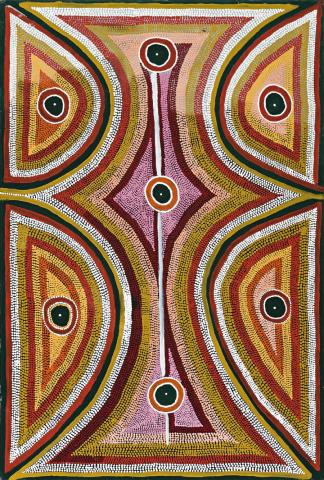RAINBOW DREAMING NEAR PURKITJI (STURT CREEK), 1999
Boxer Milner Tjampitjin
synthetic polymer paint on linen
148.5 x 100.0 cm
inscribed verso: artist's name, size, Warlayirti Artists cat. 531/99
Warlayirti Artists, Balgo Hills
Gallery Gabrielle Pizzi, Melbourne (label attached verso)
Private collection, Melbourne
Sotheby's, Melbourne, 26–27 July 2004, lot 448
The Collection of William and Lucy Mora, Melbourne
Pinti Pinti - Milk Water Country, Gallery Gabrielle Pizzi, Melbourne, 2000
This painting is set in Boxer's traditional country, along the banks of Purkitji (Sturt Creek), and depicts part of the Rainbow Dreaming Story. The white bands are clouds, as they let loose the rain onto the Sturt Creek basin, while the other bands of colour show Sturt Creek through different stages of flooding and drying out. The pink area in this painting represents the flood waters as they run between the different waterholes. The area of Milnga-Milnga is a major flood plain for Sturt Creek and is inundated every summer after the rains. This is important for all nature, including people, and the artist's family who have always lived here 'look after' the area by keeping its associated Law and ceremonies.
Boxer Milner lived at Kururrungku Community, which is also known as Billiluna. He was a traditional owner of Purkitji (Sturt Creek) and intimately knew all the facets of the river system, the country and the stories that feature in the majority of his work. Boxer's paintings show the different physical and mythological aspects of the middle and upper stretches of Sturt Creek.
His depiction of country is abundant with colour, including pinks, blues and greens that are not found elsewhere in Balgo paintings. He often depicted the flooding of the creek, illustrating the changes to the country that occurred, both during the flooding and after the water starts to recede. These floodwaters change colour, often filling with the white silt of the surrounding clay country. This is the 'milk water', which features in many of Boxer's works, providing a geometric grid against which the rest of the landscape is represented. His work includes wonderful rainbows, rain clouds and the temporary creeks that are formed during the wet season.
